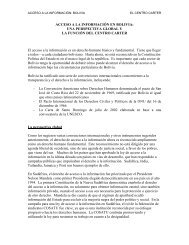Urinalysis - The Carter Center
Urinalysis - The Carter Center
Urinalysis - The Carter Center
Create successful ePaper yourself
Turn your PDF publications into a flip-book with our unique Google optimized e-Paper software.
EPITHELIAL CELLS<br />
• Normally few epithelial cells (0-2 / HPF) can be found<br />
• Appearance<br />
• <strong>The</strong>ir size differs depending on the site from which they<br />
originated.<br />
a. Those coming from renal cells<br />
- Size is small as compared to other epithelial cells<br />
- It measures 10μ to 18 μm in length, i.e., slightly larger than<br />
leukocytes<br />
- Very granular<br />
- Have refractive and clearly visible nucleus<br />
- Usually seen in association with proteins or casts ( in renal<br />
disease).<br />
b. Cells from pelvis and urethra of the kidney<br />
- Size is larger than renal epithelia’s<br />
- Those from pelvis area are granular with sort of tail, while those<br />
from urethra are oval in shape<br />
- Most of the time urethral epithelia is seen with together of<br />
leukocytes and filaments (mucus trades and large in number)<br />
- Pelvic epithelia’s seen usually with no leukocyte and mucus<br />
trade, and are few in number<br />
c. Bladder cells<br />
- Are squamious epithelial cells?<br />
- Very large in size.<br />
- Shape seems rectangular and often with irregular border.<br />
- Have single nucleus.<br />
* Here it is important to keep in mind that it is not expected from an<br />
experienced Lab. technician after simply observing epithelial<br />
cells, to say that these are urethral cells, and of pelvic origin and<br />
reporting such a false result in the laboratory request form.<br />
96
















